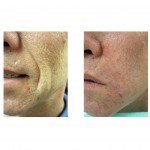
The main treatment method for deepening nasolabial folds is to soften them by pushing them out with injectable fillers. The type or name brand of injectable filler used does not make a difference in the cosmetic outcome. The folds are softened and made less deep by the ‘push’ of the injectable fillers. The result from fillers is instantaneous albeit temporary.
There are some nasolabial fold problems, however, that I do not think do well with injectable fillers. Very deep folds or inverted nasolabial folds do not usually get very satisfying results with injection methods alone. The inversion or v-shape of the fold makes any push from underneath less significant and not very long lasting. In these folds, excision produces the best result (most flattening) but the scar is not usually a good aesthetic trade-off.
An interesting approach to the inverted nasolabial fold is surgical release. Detaching the dermal attachments from the depth of the fold produces a release as a result of loosening the fixed part of the fold. This can clearly be done with surgical instruments but the entrance incision for access results in a bigger scar that is aesthetically acceptable. A special cutting wire has been developed for this application so the nasolabial folds can have a ‘wire release’. Placed through two separate stab entrances, the wire does a good job of a wide release of the overlying nasolabial fold. The immediate results are quite impressive and it is a procedure which can be done in the office under local anesthesia.
This is the best method that I have seen yet for these difficult inverted nasolabial folds. Whether long-term results bear out that it is better than injectable fillers remains to be seen. But the early results are promising.
Dr. Barry Eppley
Indianapolis, Indiana


